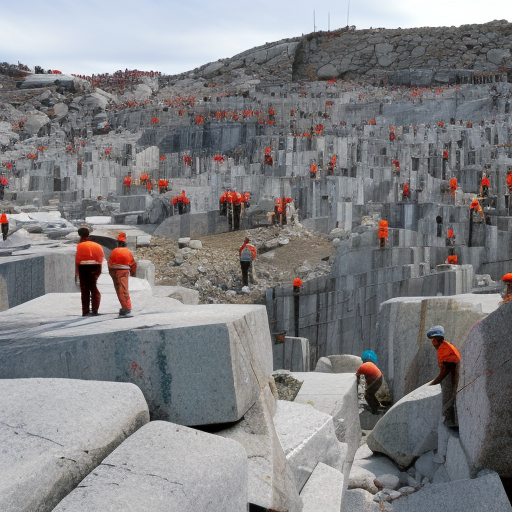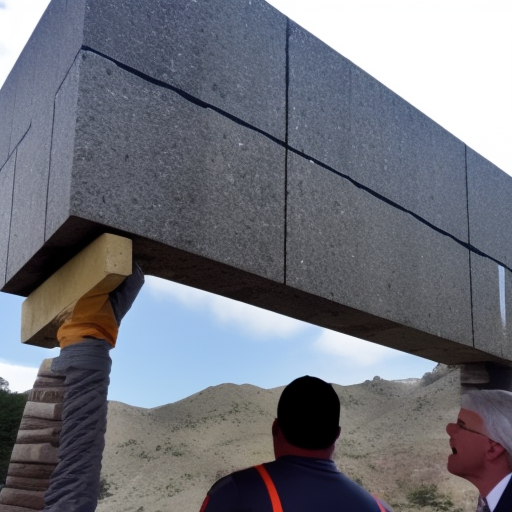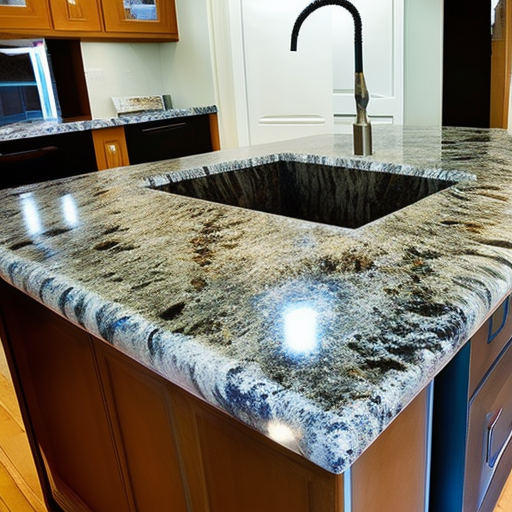If you have ever marveled at the beauty and durability of a granite countertop, you may have wondered how it made its way from a quarry to your kitchen. The journey of a granite countertop is a fascinating one, filled with intricate processes and breathtaking natural beauty. In this article, we will unveil the granite journey, from the moment it is unearthed in a quarry to its final destination in your kitchen. Join us as we explore the fascinating process of transforming granite, the exploration of the quarry itself, and how granite countertops bring a touch of nature to your kitchen. Get ready to embark on a captivating adventure through the Granite Journey from Quarry to Kitchen.
1. Unveiling the Granite Journey: From Quarry to Kitchen

Granite is a popular choice for kitchen countertops due to its durability, natural beauty, and timeless appeal. But have you ever wondered where this stunning stone comes from and how it makes its way into your kitchen? Let’s unveil the fascinating journey of a granite countertop, from the quarry to your kitchen.
The journey begins at the quarry, where massive blocks of granite are extracted from the earth. These quarries are usually located in regions abundant in granite deposits, such as Brazil, India, China, and the United States. Skilled workers use advanced machinery and techniques to carefully extract the granite blocks, ensuring minimal damage to the stone.
Once extracted, the granite blocks are transported to nearby facilities for further processing. At these processing plants, the blocks undergo a series of steps to transform them into slabs that are suitable for use as countertops. The blocks are first cut into smaller, more manageable sizes using diamond wire saws or large circular saws. Precision is crucial during this stage to ensure the slabs are cut with accuracy and minimal waste.
After the initial cutting, the slabs are meticulously polished to enhance their natural beauty. This process involves using a combination of abrasive pads and polishing compounds to achieve a smooth and lustrous finish. The level of polish can vary depending on the desired look, ranging from a matte finish to a high-gloss shine.
Once the slabs are polished, they are carefully inspected for any imperfections or structural weaknesses. Quality control measures are implemented to ensure that only the finest slabs make their way to the market. Slabs that meet the strict quality standards are then bundled, packed, and prepared for transportation to their final destination – your kitchen.
When it’s time to install the granite countertop, skilled professionals measure the dimensions of the kitchen space to ensure a precise fit. The slabs are cut and shaped according to these measurements using specialized tools and techniques. The installation process involves carefully placing the slabs onto the kitchen cabinets and securing them in place using adhesive materials specifically designed for granite.
Once installed, a granite countertop adds an elegant touch to any kitchen. Its durability and resistance to heat, scratches, and stains make it an ideal choice for busy households. Additionally, granite’s natural patterns and colors bring a unique and luxurious aesthetic to the kitchen space.
In conclusion, the journey
2. The Fascinating Process: Transforming Granite from Quarry to Kitchen Countertop

The journey of a granite countertop from quarry to kitchen is a fascinating process that involves several stages of transformation. Starting at the quarry, granite is extracted from the earth through a process called quarrying. This is done by drilling holes and inserting explosives to loosen the granite blocks from the bedrock. Once the blocks are loosened, heavy machinery is used to lift and transport them to the processing facility.
At the processing facility, the granite blocks undergo a series of cutting and shaping processes. Large diamond saws are used to slice the blocks into slabs of specific thickness. These slabs are then polished to achieve a smooth and glossy surface. The polishing process involves the use of abrasive pads and polishing compounds that bring out the inherent beauty and shine of the granite.
After the slabs are polished, they are carefully inspected for any imperfections or defects. Any flaws found are either repaired or discarded, ensuring that only the highest quality slabs make it to the next stage. The selected slabs then go through a process called templating, where precise measurements are taken to create templates for the countertops.
Once the templating is complete, the slabs are cut into individual countertop pieces according to the measurements. This is done using advanced cutting machines that ensure accuracy and precision. The cut pieces then undergo further polishing to refine the edges and corners, giving them a finished look.
Finally, the granite countertops are ready to be transported to the kitchen. They are carefully packaged and loaded onto trucks for delivery. Upon arrival, skilled installers take over and fit the countertops into place, ensuring a perfect fit and seamless integration with the kitchen design.
The journey of granite from quarry to kitchen is not only fascinating but also showcases the immense craftsmanship involved in transforming a raw material into a functional and aesthetically pleasing countertop. From the sheer power and precision of quarrying to the intricate cutting and polishing processes, every step is crucial in bringing out the natural beauty of granite. Whether it’s a small kitchen renovation or a large-scale construction project, the granite journey ensures that homeowners can enjoy the timeless elegance and durability of this remarkable stone in their kitchens.
3. Exploring the Quarry: Unearthing the Beauty of Granite for Your Kitchen

When it comes to selecting the perfect material for your kitchen countertops, granite has long been a popular choice. Known for its durability, timeless beauty, and unique patterns, granite adds elegance and sophistication to any kitchen. But have you ever wondered where this exquisite stone comes from?
The journey of a granite countertop begins deep within the earth, in a place known as a quarry. These quarries, often located in mountainous regions, are where granite is extracted from the ground. The process of quarrying granite is no small feat – it requires heavy machinery, skilled workers, and careful planning.
Exploring a quarry is like stepping into a world of natural wonder. As you enter, you are greeted by the sight of massive blocks of granite, waiting to be extracted. The first thing that strikes you is the sheer scale of the operation. Gigantic excavators and bulldozers are used to remove layers of soil and uncover the granite deposits.
Once the granite is exposed, skilled workers carefully extract the stone using diamond wire saws and drills. They must be precise, as even the smallest mistake can result in damage to the precious granite. As the blocks are cut, the unique patterns and colors of the granite are revealed, showcasing the natural beauty that lies within.
As you explore the quarry, you can’t help but be captivated by the variety of granite available. Granite comes in a wide range of colors, from classic black and white to vibrant blues, greens, and reds. Each slab tells a story, with its own distinct pattern and veining. It is this individuality that makes granite such a sought-after material for kitchen countertops.
Once the granite blocks are extracted, they are transported to a nearby facility for further processing. Here, the blocks are cut into smaller slabs, polished to perfection, and prepared for shipment to kitchen suppliers and fabricators. From the quarry to the kitchen, the journey of a granite countertop is a testament to the craftsmanship and dedication involved in bringing this natural beauty into our homes.
In conclusion, exploring the quarry is an awe-inspiring experience that allows you to witness the birthplace of your granite countertop. It is here, beneath the earth’s surface, that the true beauty of granite is unearthed. From the moment it is extracted to the time it graces your
4. Bringing Nature to Your Kitchen: How Granite Countertops Complete the Journey from Quarry to Kitchen

Granite countertops not only add a touch of elegance and sophistication to any kitchen but also bring a piece of nature directly into your home. The journey of a granite countertop, from the quarry to your kitchen, is a remarkable process that highlights the beauty and durability of this natural stone.
Starting at the quarry, granite is extracted from the earth through a series of mining techniques. This process involves carefully removing large blocks of granite from the ground, ensuring minimal damage to the stone. Once extracted, the granite blocks are transported to nearby processing facilities where they undergo various cutting and polishing techniques to transform them into usable slabs.
The next step in the granite journey is the selection and customization of the slabs for individual countertops. Each slab is carefully inspected for color, pattern, and quality to ensure it meets the customer’s expectations. Skilled craftsmen then measure and cut the slabs to fit the specific dimensions of the kitchen, taking into consideration the sink and other fixtures.
Once the slabs are cut, they are meticulously polished to achieve a smooth and glossy surface. This process not only enhances the natural beauty of the granite but also ensures its durability and resistance to stains and scratches. The final product is a stunning and unique piece of art that effortlessly combines functionality with aesthetic appeal.
Installing granite countertops in your kitchen not only adds value to your home but also provides numerous benefits. Granite is a natural stone known for its strength and durability, making it resistant to heat, scratches, and stains. Its non-porous surface also makes it hygienic and easy to clean, making it an ideal choice for busy kitchens.
Furthermore, granite countertops come in a wide variety of colors and patterns, allowing homeowners to choose the perfect option that complements their kitchen decor and personal style. The unique and natural characteristics of each slab ensure that no two granite countertops are exactly alike, making them a truly one-of-a-kind addition to any kitchen.
In conclusion, the journey of a granite countertop from quarry to kitchen is a remarkable process that brings nature’s beauty and strength into your home. By selecting and customizing the slabs, cutting and polishing them to perfection, and finally installing them in your kitchen, you can enjoy the elegance and durability of granite countertops for years to come. So, why settle for ordinary when you can bring the extraordinary into your




